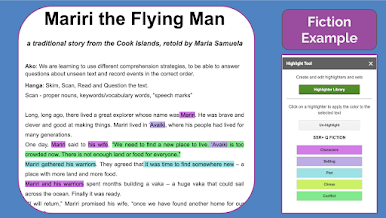Update: Here is my SSR+Q website
The problem I was observing in my classroom of Year 9/10 students at the start of the year was they were disengaged readers; they struggled to answer questions about unseen text, and they were unmotivated readers.
My initial hunch was that students were challenged by answering higher order questions; they didn’t understand what the questions were asking, therefore ākonga could not search for the answer. The reading results were surprising in that the students struggled to answer lower level questions like recalling who is the main character or describing the setting? This contradicted my hunch. Therefore, my new statement became: how might we use skimming and scanning to support students questioning of unseen text.
Throughout this design learning process I refined this project by getting feedback from a variety of sources. First of all I introduced the SSR+q process using a paper copy of the text to a small group of ākonga. We skimmed down the text to decide what genre the text was and then scanned across, using highlighters. At this point I realised that explicit teaching was needed around keywords and proper nouns. I created a Hāpara workspace and used rewindable learning to shared resources and relevant videos. Once ākonga identified the key words and proper nouns they then read through the text for meaning and finally read and answered the questions. We completed this phase as an open group discussion, which led to great reflection on the process and understanding of the text. Thank you to the small group of ākonga that made this first phase possible.
From the feedback that I received from this group of ākonga, my MIT colleagues and other kaiako I had talked to, changes were implemented and applied to a digital setting. What was created next was a Hāpara workspace reflecting the Learn|Ako - Create|Hanga - Share|Tohatroha pedagogy. The Highlight Tool found in Google Docs, extensions was utilised to enhance learning and student motivation, in the 21st century. Within the Highlighter Library different sections can be created for different genre ie non-fiction section where students added the words proper nouns, key words and speech marks, to highlight within their text. At this stage we just focused on non-fiction text. Here is an example of this workspace:
Wananga Presentation - Waipuna 2023:
























